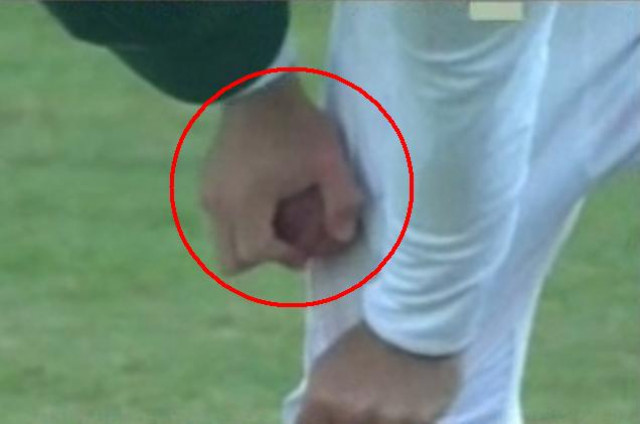2nd Test: Pakistan hang on as South Africa docked five runs for ball tampering
Pakistan close the days play at 132 for four, still behind South Africa's total by 286 runs.

Faf du Plessis was seen on TV rubbing the ball against a zipper in his trouser. PHOTO: EXPRESS NEWS screengrab.
South Africa were docked five penalty runs after umpires Rod Tucker of Australia and Ian Gould of England found the ball's condition too deteriorated.
Umpires replace ball and fine South Africa five runs for ball tampering on third day in the Dubai Test #PakvSA #cricket #wtc
— ICC (@ICC) October 25, 2013
Television replays showed South African fielder Faf du Plessis rubbing the ball on his trousers which had a zip on them, in an apparent attempt to tamper with the ball.
Pakistan at that point were struggling at 62 for three with Dale Steyn about to start the 31st over when the umpires took notice of the ball and took the decision.
Under International Cricket Council (ICC) rule 42.1 on tampering, if an umpire spots a change in the condition of the ball but doesn't know who is the culprit, he will issue a first and final warning to the captain and the ball will be changed.
In case the ball is tampered with again, the bowling team will face a five-run penalty and umpires will not only change the ball again but the captain will be held responsible and reported.
But in this case the umpires saw Du Plessis rubbing the ball in an apparent move to tamper with the ball and they called Smith and docked five penalty runs.
An ICC spokesperson confirmed the incident.
"As per 42.1 of the ICC playing conditions, the umpires replaced the ball and fined South Africa five penalty runs for ball tampering," said an ICC spokesperson.
The South African team is likely to be subjected to a post-match hearing over the incident.
Pakistan is the only other team to have been penalised with five penalty runs, during the infamous Oval Test against England in 2006.
In a sharp reaction to Australian umpire Darrell Hair's decision, then Pakistan captain Inzamamul Haq had walked off the field.
Hair then ruled that Pakistan had forfeited the match - the only such instance in Test cricket history.
Pakistani batting order in doldrums again
After dismissing South Africa for 517 on the third day, behind by 416 runs, the Pakistani lineup failed to build an opening that they desperately needed.
Both Pakistani openers were back in the pavilion at scores of zero each. Azhar Ali, often praised for his patience and Younis Khan, the senior batsman who recently expressed his outrage at being omitted from the ODI side, got out for parltry scores of 19 and 36, respectively.
At the end of the days play, Pakistan were reeling at 132 for four with Misbah (42) and Shafiq (28) on the crease, still behind South Africa's total by 286 runs.
Earlier, South Africa resumed their first innings in the morning on 460-4, losing AB de Villiers for 164 and Graeme Smith on 234 after they put on a record 338-run partnership.
South Africa took a huge 418-run lead over Pakistan's first innings total of 99.
For Pakistan off-spinner Saeed Ajmal had finished with 6-151 while paceman Mohammad Irfan took 3-102 after an extended two-and-a-half hour session due to Friday prayers.
Pakistan lead the two-match series 1-0 after winning last week's first Test in Abu Dhabi by seven wickets.
Notwithstanding an early loss of three wickets in their second innings, Pakistan had chased down their target of 40 runs to complete a comprehensive overall victory against the number one test team South Africa on October 17 in the first Test between the two teams at Abu Dhabi.
South Africa were bowled out for 232, leaving Pakistan an easy target of 40 runs for their first test victory against SA since 2011.



















COMMENTS
Comments are moderated and generally will be posted if they are on-topic and not abusive.
For more information, please see our Comments FAQ